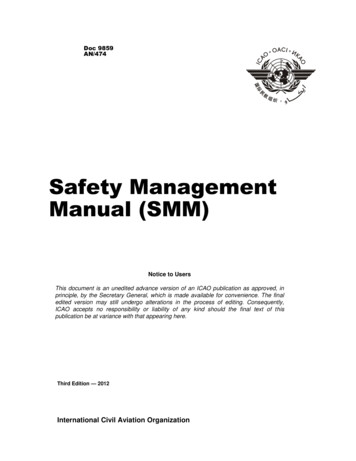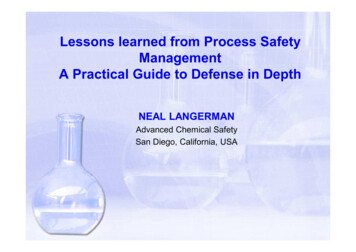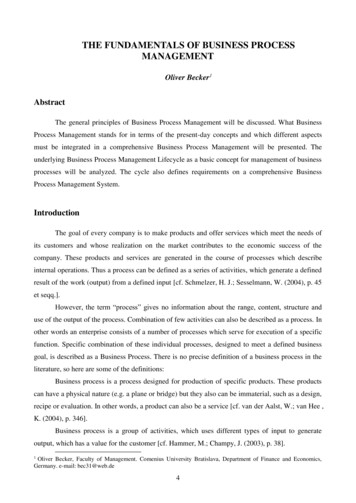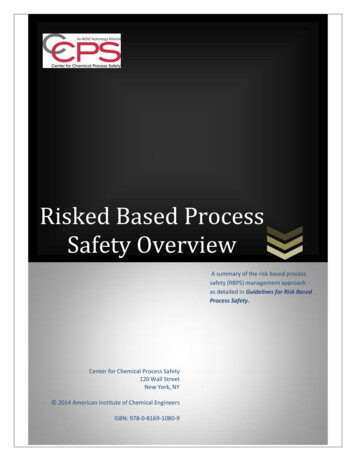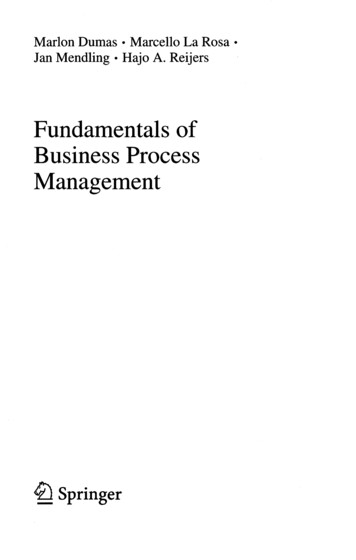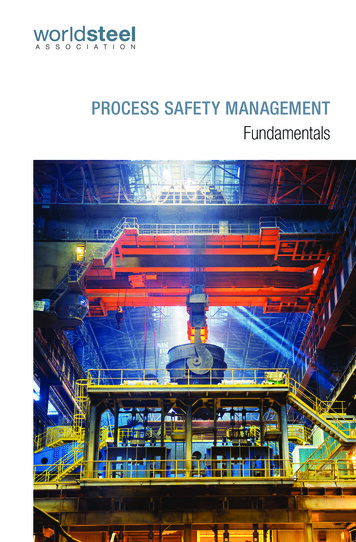
Transcription
PROCESS SAFETY MANAGEMENTFundamentals1
CONTENTSSCOPE“ Nothing is more important thanthe safety and health of the peoplewho work in the steel industry. ”worldsteel Board of DirectorsScope 3Process Safety Management fundamentals 6Probability and pyramid12Definitions and calculations 14SIX SAFETY AND HEALTH PRINCIPLES FOR THE STEEL INDUSTRY A ll injuries and work-related illness can and must be prevented. M anagers are responsible and accountable for safety and healthperformance. Employee engagement and training is essential. Working safely is a condition of employment. E xcellence in safety and health drives excellent business results. Safety and health must be integrated into all business managementprocesses.The World Steel Association (worldsteel) is one of the largest and most dynamicindustry associations in the world, with members in every major steel-producingcountry. worldsteel represents steel producers, national and regional steelindustry associations, and steel research institutes. Members represent around85% of global steel production.FOUR FOCUS AREASSafety Culture and LeadershipThis publication is printed on Olin paper. Olin is certified by the ForestStewardship Council as environmentally-responsible paper. World Steel Association, 2019Cover photo: NLMK thManagementProcessSafetyManagement3
PROCESS SAFETY MANAGEMENTProcess Safety Management (PSM) is a blend of engineering, operations andmanagement skills focused on preventing catastrophic accidents, particularlystructural collapse, explosions, fires and toxic releases associated with lossof containment of energy or dangerous substances such as toxic gases,molten metal, chemicals and petroleum products.The manufacturing of steel involves processes with intrinsic hazards thatneed careful management. The measures needed to control these hazardsare often complex. The focus of process safety management is not limited toprotecting the people within the company but also includes the environment,assets and surrounding community.Our PSM fundamentals encourage steelmakers to take a risk-based, ratherthan compliance-based strategy to the prevention of PSM incidents andfocus resources on high-risk activities.SIX PROCESS SAFETY MANAGEMENT FUNDAMENTALS1. Ensure there is a commitment to Process Safety Management.2. Establish a hazard evaluation and risk analysis programme.3. Implement and maintain a risk management and control system.4. Strive to excellence in learning from experience.5. Utilise continuous improvement to ensure Process Safety Managementeffectiveness.6. Maintain a sense of vulnerability in Process Safety Management.4Ternium5
PROCESS SAFETY on andrisk analysis1. Ensure there is a commitment to Process SafetyManagement.The commitment to Process Safety Management is the foundation ofprocess safety excellence and requires five elements:1. Process safety culture in the workplace4. Workforce competencies2. Workforce involvement and participation5. Performance based onstandards.3. Stakeholder nse ofvulnerability03Riskmanagementand control Is Process Management Safety a core valuein your organisation?2. Establish a hazard evaluation and risk gfromexperienceThe understanding of process safety hazards and risks helps organisationsto allocate resources effectively. This process comprises two elements:1. Process and equipment knowledge2. Hazard identification andrisk analysis (HIRA process). Do you understand your hazards and risks?67
PROCESS SAFETY MANAGEMENTFundamentals3. Implement and maintain a process safety riskmanagement and control system.Risk management and control helps organisations to operate and maintainprocesses with excellence, ensuring risk mitigation, management of changeand keeping the risk tolerable. It also ensures that the workplace isprepared in the event of an emergency. This process requires six elements:1. Good operational practices4. Training and performance2. Asset integrity and reliability5. Management of change3. Management of contractors6. Emergency preparedness. Do you manage your risks to keep them on a tolerable level? Do you have emergency plans in all your units?4.Strive to excellence in learning from experience.The learning from experience programme must maintain vigilance,utilise internal and external sources of information, take action andensure effectiveness. This process comprises two elements:1. Incident investigations2. Measures and metrics. A re you monitoring and acting on internal and external sourcesof information?8Tata Steel Limited9
PROCESS SAFETY MANAGEMENTFundamentals5. Utilise continuous improvement to ensureProcess Safety Management effectiveness.Routinely reviewing the Process Safety Management system to stimulatecontinuous improvement will ensure effectiveness in the fundamentalsof Process Safety Management. This process comprises two elements:1. Auditing2. Management reviewand governance. A re you performing reviews and auditing your Process SafetyManagement system?6. Maintain a sense of vulnerability in ProcessSafety Management.Developing a sense of vulnerability drives organisations to seek andmaintain a clear understanding of risk and the means to control it. Are you promoting the sense of vulnerability in your organisation?10thyssenkrupp AG11
PROBABILITY AND PYRAMIDTier 1 – Is a loss of primary containment(LOPC) with the greatest consequences,Low probabilityHigh probabilitye.g. fires and explosions causing lost timeHigh severityinjuries, one or multiple fatalities orsignificant financial impact (greater thanTIERProcesssafety01organisational tolerance levels) or seriousenvironmental impact or harm to thecommunity or substantial reputationimpact.Tier 2 – LOPC with the lesserTIER02consequences, e.g. fires and explosionscausing a recordable injury or financialimpact (within organisational tolerancelevels) or environmental impact or low harmto the community or reputation impact.Low severityOccupationalsafetyTIER03Tier 3 – Typically represents a challengeto the barrier system and near misses,e.g. deviations in safety operational limits,potential LOPC.Tier 4 – Typically represents performanceTIER04of individual components of the barriersystem and are comprised of operatingdiscipline and management systemperformance (e.g. KPI of PSM).1213
DEFINITIONS AND CALCULATIONSClear definitions and calculationmethodologies ensure the industry isapplying a common standard and metric.Containment, primaryFireProcessA tank, vessel, pipe, truck, rail car,or other equipment designed tokeep material within it - typically forthe purposes of storage, separation,processing, or transfer of material.Any combustion resulting from aLOPC, regardless of the presenceof flame. This includes smouldering,charring, smoking, singeing,scorching, carbonizing, or theevidence that any of these haveoccurred.Production, distribution, storage,utilities, or pilot plant facilities used inthe manufacture of steel productsand co-products. This includesprocess equipment (e.g. reactors,vessels, piping, electric arcfurnaces, blast furnaces, cokeovens, boilers, pumps,compressors, exchangers, coolingContainment, secondaryAn impermeable physical barrierspecifically designed to mitigate theimpact of materials that have breachedprimary containment. Secondarycontainment systems include, butare not limited to tank dikes, curbingaround process equipment, drainagecollection systems, the outer wall ofopen top double walled tanks, etc.Loss of primary containment(LOPC)ExplosionMolten metalA release of energy that causes apressure discontinuity or blast wave(e.g. detonations, deflagrations, andrapid releases of high pressure causedby rupture of equipment or piping).During the manufacture of steel andits co-products, different types ofmolten metals are used, such aszinc, iron and the steel itself.14An unplanned or uncontrolledrelease of any material from primarycontainment, including non-toxic andnon-flammable materials (e.g. steam,hot water, nitrogen, compressedCO2, or compressed air).towers, refrigeration systems, etc.),storage tanks, ancillary supportareas (e.g. boiler houses and wastewater treatment plants), on-siteremediation facilities, and distributionpiping under control of the company.Note: All definitions are reproducedfrom API ANSI RP 754 except for:Molten metal and Process.Process Safety Events Rates (PSER) are calculated as:Total TIER 1 PSER * 1,000,000 / hours workedTotal TIER 2 PSER * 1,000,000 / hours workedTIER 3 and 4 are leading indicators. They should be managed and becompliant with the PSM system.15
World Steel AssociationAvenue de Tervuren 2701150 BrusselsBelgiumT: 32 (0) 2 702 89 00F: 32 (0) 2 702 88 99E: steel@worldsteel.orgC413 Office BuildingBeijing Lufthansa Center50 Liangmaqiao RoadChaoyang DistrictBeijing 100125ChinaT : 86 10 6464 6733F : 86 10 6468 0728E : china@worldsteel.orgworldsteel.org16
Process Safety Management effectiveness. Routinely reviewing the Process Safety Management system to stimulate continuous improvement will ensure effectiveness in the fundamentals of Process Safety Management. This process comprises two elements: . 6 Mn tainai a sense of vulnerability in


